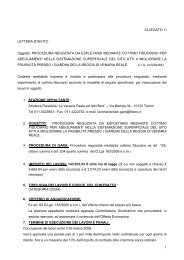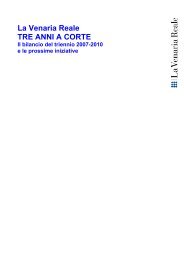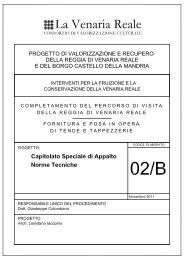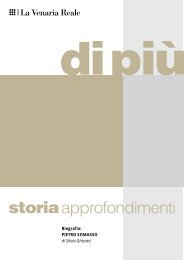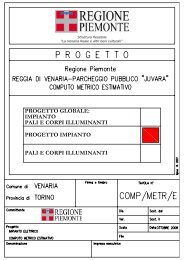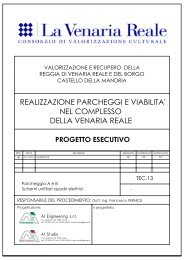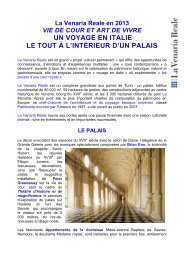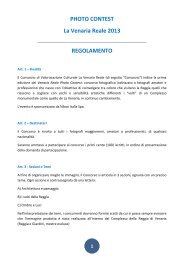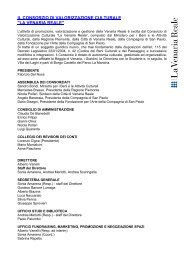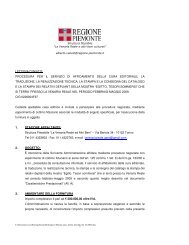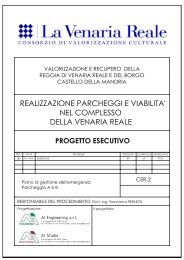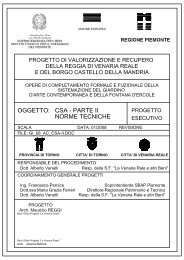Torino britannica. - The British School at Rome
Torino britannica. - The British School at Rome
Torino britannica. - The British School at Rome
- No tags were found...
You also want an ePaper? Increase the reach of your titles
YUMPU automatically turns print PDFs into web optimized ePapers that Google loves.
Edward Chaney<strong>Torino</strong> Britannica and the Cultural Memory of Egypt:Stuarts, Savoys and the Divine Right of Kings.My paper begins by investig<strong>at</strong>ing early-seventeenth-century Anglo-Torinese connections andpossible links with the so-called Mensa Isiaca, an artefact of gre<strong>at</strong> prestige in this period. Ataround the time Charles I acquired most of the rest of the Gonzaga collection, this seems tohave been acquired by Carlo Emmanuele I of Savoy. <strong>The</strong> subject of a learned tre<strong>at</strong>ise publishedby Lorenzo Pignoria in 1605, until Champollion deciphered the hieroglyphics and Drovetti gre<strong>at</strong>lyenlarged the collection, the Mensa Isiaca starred as the prize exhibit and inspir<strong>at</strong>ion for wh<strong>at</strong>became one of the gre<strong>at</strong>est Egyptian Museums in the world. ‘<strong>Torino</strong> Britannica and the CulturalMemory of Egypt’ is a two-stranded essay which examines the Divine Right of Kings as the legacyof ancient Egypt. <strong>The</strong> extent to which the Stuarts and the Dukes of Savoy, ever-anxious to acquiresimilarly regal st<strong>at</strong>us, were influenced by Egyptian ideas was for the most part unconsciousbut growing post-medieval interest in the visible manifest<strong>at</strong>ions of this still largely buriedciviliz<strong>at</strong>ion tells us much about our own (and its discontents). More specifically it cre<strong>at</strong>es a newprism through which to investig<strong>at</strong>e the evolution of the United Kingdom and united Italy.Edward Chaney is the Professor of Fine and Decor<strong>at</strong>ive Arts and Founding Chair of theHistory of Collecting Research Centre <strong>at</strong> Southampton Solent University. He is author of severalbooks on Anglo-Italian subjects and is a Commend<strong>at</strong>ore of the Italian Republic. In 2010-12 hewas awarded a Leverhulme Major Research Fellowship to work on the Idea of Ancient Egypt inEarly Modern Britain.
Annarita Coltur<strong>at</strong>oCon talento e intraprendenza:musicisti piemontesi a Londra nel secondo Settecento«<strong>The</strong> arrival of Giardini in London, in the spring of this year, forms a memorable æra in theinstrumental music of this kingdom», scriveva Charles Burney nella sua General History ofMusic d<strong>at</strong>ando l’esordio inglese di Felice Giardini al 1750 anziché – come sembra certo – al1751. Grazie all’immedi<strong>at</strong>o successo come violinista e did<strong>at</strong>ta, al car<strong>at</strong>tere intraprendente e alsostegno di alcuni dei più influenti nomi dell’aristocrazia <strong>britannica</strong>, il compositore (<strong>Torino</strong>, 1716- Mosca, 1796) fu tra le personalità che dal punto di vista concertistico ed editoriale segnaronomaggiormente il secondo Settecento musicale londinese. Non l’unico, a provenire dal Regnodi Sardegna e dalle nutrite file degli strumentisti piemontesi noti in ambito internazionale peril loro virtuosismo e le loro qualità interpret<strong>at</strong>ive. Nel 1767, a incantare il pubblico con il suotalento, popolare i c<strong>at</strong>aloghi degli editori con le sue composizioni e guidare l’orchestra del King’s<strong>The</strong><strong>at</strong>re (avvi<strong>at</strong>a da Giardini a una «new discipline, and a new style of playing», stando ancora aBurney) giunse Gaetano Pugnani (<strong>Torino</strong>, 1731-1798), come Giardini allievo del ‘padre’ della scuolaviolinistica piemontese, Giovanni B<strong>at</strong>tista Somis: una scuola la cui fama in Europa, Inghilterracompresa, fu definitivamente decret<strong>at</strong>a da Giovanni B<strong>at</strong>tista Viotti (Fontanetto Po, Vercelli, 1755),«the celebr<strong>at</strong>ed Viotti, supposed to be the first Violin in the world» – come scrisse il celebreimpresario Johann Peter Salomon – che proprio nella capitale inglese morì nel 1824 al termine diun’esistenza avventurosa trascorsa sulle ribalte più prestigiose e a cont<strong>at</strong>to con gli ambienti piùcolti e aristocr<strong>at</strong>ici del tempo.Annarita Coltur<strong>at</strong>o è ricerc<strong>at</strong>rice presso l’Università di <strong>Torino</strong> (Dipartimento di StudiUmanistici), dove insegna Bibliografia musicale. Membro del comit<strong>at</strong>o di redazione di «Fontimusicali italiane» (periodico della Società Italiana di Musicologia), del consiglio direttivodell’Istituto per i Beni Musicali in Piemonte e del comit<strong>at</strong>o scientifico dell’orchestra AcademiaMontis Regalis, responsabile di vari progetti di ricerca, ha f<strong>at</strong>to parte dei comit<strong>at</strong>i scientificidi mostre e convegni. Ha cur<strong>at</strong>o i c<strong>at</strong>aloghi di fondi musicali di rilevanza internazionale,collabor<strong>at</strong>o ad alcune delle più autorevoli opere collettive di ambito musicale, dedic<strong>at</strong>onumerosi studi in particolare al Settecento musicale italiano (l’ultima monografia, Mettere inscena la regalità. Le feste te<strong>at</strong>rali di Gaetano Pugnani al Regio di <strong>Torino</strong>, è uscita nel 2012).
Paolo CornagliaIl giardino inglese in Piemonte a fine Settecento:declinazioni pittoresche, anglo-cinesi e paesaggistiche.Nel suo Coup d’oeil sur Beloil, pubblic<strong>at</strong>o nel 1786, il principe de Ligne, testimone d’eccezionee in presa diretta del diffondersi del gusto pittoresco in Europa, stronca con poche parole lasecolare vicenda dei giardini alla francese: “Alberi esausti, carpinete languenti, sentieri ar<strong>at</strong>idove è impossibile passaggiare, una verzura mal<strong>at</strong>iccia, fieno al posto del pr<strong>at</strong>o”. È la nuovasensibilità nei confronti della n<strong>at</strong>ura che nei decenni procedenti è m<strong>at</strong>ur<strong>at</strong>a in Gran Bretagna ein quel momento sta guadagnando posizione grazie anche alla diffusione di modelli <strong>at</strong>traversopubblicazioni come i ventuno cahiers (1775-89) dei Jardins Anglo-chinois di Le Rouge. Il nuovospirito del giardino inglese giunge in Piemonte <strong>at</strong>traverso queste pubblicazioni ma anche<strong>at</strong>traverso l’osmosi con i paesi confinanti o specifici apporti leg<strong>at</strong>i al Regno Unito. Se unadiretta influenza <strong>britannica</strong> è costituita dal progetto di Giovanni B<strong>at</strong>tista Borra (<strong>at</strong>tivo a NorfolkHouse a Londra e nel parco di Stowe) per il castello di Racconigi in forma di vera e propria villainglese (1755), giardini ufficialmente “anglo-cinesi” o comunque pittoreschi o sono progett<strong>at</strong>ida Gugliemo Gullini nel 1784 per i Villa a Villastellone, da Giacomo Pregliasco nel 1787 per iCarignano a Racconigi e da Leopoldo Pollack (<strong>at</strong>tivo nel Lombardo-Veneto austriaco) nel 1796 perFaustina Mazzetti a Riva di Chieri. Un apporto diretto dalla Gran Bretagna, in ambito strettamenteleg<strong>at</strong>o al progetto di giardino, si registra però a fine secolo: per i già cit<strong>at</strong>i Villa di Villastellonelo scozzese John Wallace interviene tra il 1784 e il 1804 con un doppio registro: un approcciopittoresco <strong>at</strong>tento alle fabriques per quanto riguarda la zona di parco adiacente alla villa e ungrande respiro paesaggistico-rurale alla Capability Brown nel grandissimo parco circostante. Ilnuovo secolo sarà poi te<strong>at</strong>ro dei grandi progetti paesaggistici del franco-tedesco Xavier Kurten,ma è già un capitolo successivo.Paolo Cornaglia, Architetto, Dottore di ricerca in Storia e critica dei Beni architettonici eambientali, diplom<strong>at</strong>o all’Ecole des Hautes Etudes en Sciences Sociales di Parigi, è ricerc<strong>at</strong>orepresso il Dipartimento di Architettura e Design del Politecnico di <strong>Torino</strong>, presso il quale èdocente di Storia dell’architettura e della città e di Storia dei giardini. Svolge <strong>at</strong>tività di ricercasul tema della residenza nobiliare e di corte dal XVII al XIX secolo, focalizzando gli ambitidell’architettura, della distribuzione, della decorazione e dei giardini. È inoltre consulente delCentro Studi del Consorzio La Venaria Reale.
Edward Corp<strong>The</strong> Court of Turin and the English Succession, 1712-1720<strong>The</strong> Bill of Rights of 1689, the Act of Settlement of 1701, and the Tre<strong>at</strong>y of Union (r<strong>at</strong>ified in 1707)excluded all C<strong>at</strong>holics from the succession to the <strong>British</strong> thrones and obliged the Stuart KingJames II and his family to live abroad in exile. Yet many people, both in the <strong>British</strong> Isles and incontinental Europe, refused to accept this st<strong>at</strong>utory interference with the royal succession. Forthem, the Jacobites and their allies, James II was succeeded in 1701 by his son James III as thelegitim<strong>at</strong>e King of England, Scotland and Ireland. James III was young and unmarried, but he hadan elder half-sister (Queen Anne) and a younger sister (Princess Louise-Marie).<strong>The</strong> de<strong>at</strong>h in 1712 of James III’s younger sister, followed by the de<strong>at</strong>h of Queen Anne in 1714,meant th<strong>at</strong> Anna Maria, Duchess of Savoy, became the Jacobite heiress presumptive to the<strong>British</strong> thrones. She retained this position until the end of 1720 when James III’s wife, QueenClementina, whom he had married the previous year, gave birth to Prince Charles, the first of theirtwo sons. This paper will consider the <strong>at</strong>titude of Vittorio Amadeo, Duke of Savoy, to his wife’s (andhis own two sons’) claim to the <strong>British</strong> thrones, and how it impacted on his rel<strong>at</strong>ions with James IIIduring the short period when Vittorio Amadeo was also King of Sicily. Although dynastically linkedand not unsymp<strong>at</strong>hetic to James, Vittorio Amadeo’s own ambitions conflicted with and weregiven priority over those of his wife. As one Jacobite put it in 1716, ‘the King of Sicily’s politics aremore inclined to present preserv<strong>at</strong>ion than to future hopes’. In 1716-17, when James III was mostvulnerable, Vittorio Amadeo refused all his requests for help. <strong>The</strong> King of Sicily was, however,prepared to help James get married, as th<strong>at</strong> might result in the birth of a Stuart prince to replacehis wife Anna Maria as the Jacobite heiress.Edward Corp is Emeritus Professor of <strong>British</strong> History <strong>at</strong> the Universite de Toulouse [N.B.no accents on this keyboard]. His public<strong>at</strong>ions include <strong>The</strong> King over the W<strong>at</strong>er: Portraits of theStuarts in Exile after 1689 (N<strong>at</strong>ional Galleries of Scotland, 2001) and a three volume history ofthe Jacobite courts: A Court in Exile: <strong>The</strong> Stuarts in France, 1689-1718 (Cambridge UniversityPress, 2004), <strong>The</strong> Jacobites <strong>at</strong> Urbino (Palgrave Macmillan, 2009) and <strong>The</strong> Stuarts in Italy,1719-1766 (Cambridge University Press, 2011).
Paolo Cozzo“La metropolitaine des c<strong>at</strong>holiques”.La cappella dell’ambasci<strong>at</strong>a di Savoia nella Londra di Giorgio II.La relazione intende far luce sulla chiesa dell’ambasci<strong>at</strong>a sarda a Londra nel XVIII secolo. Illuogo di culto, aperto nella capitale <strong>britannica</strong> in concomitanza con l’acquisizione della coronadi Sardegna da parte dei Savoia, divenne in breve tempo un punto di riferimento religioso nonsolo per i sudditi sabaudi, ma anche per i c<strong>at</strong>tolici londinesi. Qui inf<strong>at</strong>ti, più che in altre cappelledelle rappresentanze diplom<strong>at</strong>iche delle altre potenze c<strong>at</strong>toliche, quanti avevano continu<strong>at</strong>oad essere fedeli alla Chiesa di Roma trovarono assistenza spirituale e personale ecclesiasticodisponibile a soddisfare la varie esigenze (innazitutto di car<strong>at</strong>tere sacramentale) dconnesse allavita religiosa. la funzione di chiesa parrocchiale assunta dalla cappella sabauda anche per moltisudditti britannici ne fece dunque un elemento assai signific<strong>at</strong>ivo nelle relazioni politiche ediplom<strong>at</strong>iche fra le due corti.Paolo Cozzo (Pinerolo, 1972) è ricerc<strong>at</strong>ore di Storia del Cristianesimo e delle Chiese presso laFacoltà di Scienze Politiche dell’Università di <strong>Torino</strong>. Il suoi interessi sono rivolti alla storia delleistituzioni ecclesiastiche e della vita religiosa in età moderna e contemporanea, con particolare<strong>at</strong>tenzione ai rapporti fra politica, religione e devozione negli st<strong>at</strong>i di Antico Regime.
Francesca FediVittorio Alfieri e la «repubblica inglese»:riflessioni su un’affinità elettivaNei suoi qu<strong>at</strong>tro viaggi in Inghilterra, tra il 1768 e il 1791, Vittorio Alfieri raccolse impressionied esperienze che diedero m<strong>at</strong>eria alla costruzione di un’immagine quasi ‘mitica’ del mondobritannico: immagine, peraltro, già deline<strong>at</strong>a nei suoi tr<strong>at</strong>ti essenziali negli anni della formazione,a <strong>Torino</strong>, e certo influenz<strong>at</strong>a (in positivo) dal confronto col modello di altre realtà ‘nazionali’, inprimo luogo quella francese.La relazione si propone di interpretare gli episodi più signific<strong>at</strong>ivi dei soggiorni inglesi raccont<strong>at</strong>inell’autobiografia di Alfieri, alla luce degli sviluppi del suo pensiero politico (segn<strong>at</strong>i in profonditàdalla Rivoluzione Americana e da quella Francese, ma anche dalla riflessione sul retaggiodella Glorious Revolution) e <strong>at</strong>traverso un’analisi il più possibile esaustiva della rete di rapportistabiliti via via dal conte con diplom<strong>at</strong>ici, viaggi<strong>at</strong>ori, e personalità di rilievo nell’Inghilterracontemporanea.Francesca Fedi si è laure<strong>at</strong>a in Letter<strong>at</strong>ura Italiana a Pisa, perfezionandosi presso la ScuolaNormale. Dopo un periodo di assistent<strong>at</strong>o a Zurigo ha insegn<strong>at</strong>o nei Licei e, dal 1998, pressol’Università di Parma. Dal dicembre 2012 è docente all’Università di Pisa.I suoi interessi di ricerca sono riconducibili alle linee seguenti: (1) utopia e paradosso nellacultura del primo Cinquecento, con particolare riguardo alle opere di Machiavelli; (2) letter<strong>at</strong>urae te<strong>at</strong>ro nella Parma settecentesca; (3) cultura massonica e generi letterari in età illuministica(4) la poetica e l’estetica del Neoclassicismo; (5) la cultura figur<strong>at</strong>iva e il pensiero politico diLeopardi.
Christopher M. S. JohnsVanderbilt UniversityChinoiserie in Piedmont:An Intern<strong>at</strong>ional Language of Diplomacy and ModernityIn 1713, as a result of the Tre<strong>at</strong>y of Utrecht th<strong>at</strong> ended the War of Spanish Succession, the Houseof Savoy obtained a prize it had sought for gener<strong>at</strong>ions: a royal title. Vittorio Amedeo II (reigned1684-1730) was recognized as King of Sicily, a title he had to exchange for the lesser kingdom ofSardinia in 1720, but he remained a king. To enhance the royal title and to place himself on parwith other monarchs, Vittorio Amedeo began the transform<strong>at</strong>ion of his capital, Turin, into oneof the most elegant and sophistic<strong>at</strong>ed cities of ancien régime Europe. This activity included theurbanistic renewal of the urban fabric and the construction of churches, palaces and chapels.When he abdic<strong>at</strong>ed in 1730, Turin was a major Italian city and a major stop on the Grand Tour.A notable fe<strong>at</strong>ure of the Savoyard dynasty’s cultural initi<strong>at</strong>ives is the inclusion of both interior andgarden décor in the fashionable chinoiserie mode, a European exoticist idiom vaguely inspired byChina. Chinoiserie was a Rococo style th<strong>at</strong> emphasized <strong>at</strong>tenu<strong>at</strong>ed human forms, rare plants andanimals. It often included singeries, visually fusing Chinese and monkeys. This was done in part toestablish a hierarchical rel<strong>at</strong>ionship between Europe and China th<strong>at</strong> favored the l<strong>at</strong>ter, especiallyafter the Qing emperors closed the C<strong>at</strong>holic missions and refused to trade on equal terms withthe West.Chinoiserie was popular in Italy, and Turin was its epicenter. Chinoiserie furniture, screens,paintings, silks, lacquer panels and garden ornaments, among other forms of visual culture,are ubiquitous in Savoyard sites: the Palazzo Reale, Venaria Reale, Palazzina della Caccia <strong>at</strong>Stupinigi and Villa della Regina, among others. To the Piedmontese dynasty, chinoiserie signifiedcurrent fashion, cultural sophistic<strong>at</strong>ion, global awareness and, above all, modernity. This paperinvestig<strong>at</strong>es the ubiquity of Piedmontese chinoiserie in the context of royal commissions andpriv<strong>at</strong>e aristocr<strong>at</strong>ic p<strong>at</strong>ronage with an eye to understanding its popularity as a vital signifierof modernity. It also makes connections between <strong>British</strong> chinoiserie and its northwesternItalian counterpart in several media. My goal is to begin a discussion of chinoiserie th<strong>at</strong> goesbeyond Rococo stylistic consider<strong>at</strong>ions and positions it in the intern<strong>at</strong>ional language of moderndiplomacy and cultural exchange.Christopher M. S. Johns is Norman and Roselea Goldberg Professor of History of Art <strong>at</strong>Vanderbilt University. His research interests include art, architecture and visual culture of the
eighteenth century. Johns is the author of four books: Papal Art and Cultural Politics: <strong>Rome</strong> in theAge of Clement XI (Cambridge: 1993); Antonio Canova and the Politics of P<strong>at</strong>ronage in Revolutionaryand Napoleonic Europe (California: 1998); <strong>The</strong> Visual Culture of C<strong>at</strong>holic Enlightenment (PennSt<strong>at</strong>e: to appear in 2014); and China and the Church: Chinoiserie in Global Context (Washington: inpress). He is a fellow of the Center for Advanced Study in Visual Art and the American Academyin <strong>Rome</strong>, where he was Resident in History of Art in 2004.
Christopher Alastair LaingA Plurality of Pluras:Members of the Plura Family and their Work for the <strong>British</strong>A plurality of Pluras ? or just a triad ? - two (or three?) of whom worked in England. <strong>The</strong> first – whodid not – was Carlo Giuseppe (1655-1737) of Lugano, a sculptor working in Turin in marble, wood,and even perhaps papier mâché. Next is the mysterious Plura who collabor<strong>at</strong>ed with the Ticinesestuccador Giovanni Bagutti <strong>at</strong> Castle Howard in 1711 – but seemingly worked nowhere else inBritain or on the Continent. Giuseppe, or Joseph ( ? – 1756), son of Carlo Giuseppe,seems to havetrained as a sculptor in Turin, to which he was on the point of returning when he died. By 1749 hehad come to B<strong>at</strong>h and married the daughter of a building contractor there. He is best known forthe drawing-room group in marble of Diana and Endymion (1751; Holburne Museum of Art,B<strong>at</strong>h)th<strong>at</strong> he fruitlessly exhibited and advertised there and in London. His son, Joseph II (1753 - ? ),trained <strong>at</strong> the Royal Academy and worked for Nollekens, before going to Italy, where he visitedNaples with Thomas Jones in 1778. Back in London in 1782, his last recorded act was to exhibit a“busto of the Abbé Grant <strong>at</strong> <strong>Rome</strong>” <strong>at</strong> the R.A. in 1786.Alastair Laing began by studying South German Rococo architecture and stucco, but sincebeing one of the cur<strong>at</strong>ors of the François Boucher exhibition <strong>at</strong> the Met, the Detroit Institute ofArts, and the Grand Palais in Paris in 1986-87, and editor and main author of the c<strong>at</strong>alogue, hehas devoted himself to th<strong>at</strong> artist. Between 1986 and 2013 he was Adviser/Cur<strong>at</strong>or of Pictures &Sculpture for the N<strong>at</strong>ional Trust, mounting its centenary exhibition, In Trust for the N<strong>at</strong>ion, <strong>at</strong>the N<strong>at</strong>ional Gallery in 1995-96, and overseeing the public<strong>at</strong>ion of the 13,500-odd oil paintingsin its houses for the Public C<strong>at</strong>alogue Found<strong>at</strong>ion (to be published in June).
Tommaso ManfrediArchitetti e Re nell’Europa del Grand Tour: da Wren a JuvarraNell’Europa degli st<strong>at</strong>i nazionali consolid<strong>at</strong>i alla fine del Seicento vi erano due diversi modelli diarchitetto regio, inteso come responsabile della gestione e della progettazione del p<strong>at</strong>rimoniodella corona: quello francese e quello britannico, entrambi intrinseci ai rispettivi sistemi politici.Il Premier architecte du Roi, nella persona di Jules Hardouin-Mansart (in carica dal 1681 al 1708),era espressione del sistema di potere piramidale e burocr<strong>at</strong>ico consolid<strong>at</strong>o da Jean-BaptisteColbert al tempo di Luigi XIV. Il Surveyor of the King’s Works, nella persona di Christopher Wren (incarica dal 1669 al 1718), rifletteva il car<strong>at</strong>tere meno accentr<strong>at</strong>o degli organi di governo britannici,coordinandosi con la figura del Comptroller of the King’s Works. Anche sul piano professionalevi erano profonde differenze tra questi due modelli. L’inglese Wren, scienzi<strong>at</strong>o di formazione,operava sperimentalmente senza il supporto di un sistema accademico disciplinare. Il franceseHardouin-Mansart guidava un appar<strong>at</strong>o estremamente specialistico e fortemente integr<strong>at</strong>oall’Académie Royale d’Architecture a lui sottoposta Anche per questo il Premier architecte diLuigi XIV costituì la figura di architetto regio esemplare per le corti assolutistiche dell’Europacontinentale, compresa quella dei Savoia a <strong>Torino</strong>.Nel 1714 Vittorio Amedeo II di Savoia assegnò a Filippo Juvarra la carica di suo primo architetto,affidandogli un progetto artistico di lunga dur<strong>at</strong>a mir<strong>at</strong>o a esaltarne la nuova dignità regale sulpiano interno e internazionale. Più di ogni altro architetto regio del Settecento, Juvarra ebbe lapossibilità di confrontare la n<strong>at</strong>ura del suo ruolo nel contesto europeo viaggiando in Portogallo,Inghilterra, Francia e Spagna. Ciò offre lo spunto per una riflessione generale sull’identità e lafunzione degli architetti regi nell’Europa del Grand Tour e sulla loro influenza nella definizionee nella diffusione dei linguaggi architettonici più aulici. Al contempo si intende offrire un’ampiapanoramica sui processi di assunzione nel circuito internazionale degli architetti di corte, menostudi<strong>at</strong>o, ma non meno vivace e stimolante di quelli dei pittori e dei musicisti di cui Londra e<strong>Torino</strong> rappresentarono poli molto diversi, ma ugualmente signific<strong>at</strong>ivi.Tommaso Manfredi, architetto, svolge <strong>at</strong>tività did<strong>at</strong>tica e di ricerca presso l’UniversitàMediterranea di Reggio Calabria – Dipartimento P<strong>at</strong>rimonio, Architettura e Urbanistica. Sioccupa di storia dell’architettura e della città in età moderna e contemporanea, con particolareriferimento a Francesco Borromini, Carlo Fontana, Filippo Juvarra, Ferdinando Fuga, LuigiVanvitelli, Francesco Milizia, alla formazione degli architetti europei nel Settecento enell’Ottocento, alla storia urbana di Roma, alla tr<strong>at</strong>t<strong>at</strong>istica del Seicento e del Settecento, su cuiha pubblic<strong>at</strong>o numerosi contributi. È autore delle monografie I Virtuosi al Pantheon. 1700-1758(con G. Bonaccorso, 1998), La costruzione dell’architetto. Maderno, Borromini, i Fontana e laformazione degli architetti ticinesi a Roma (2008); Filippo Juvarra. Gli anni giovanili (2010).
membro della Commissione scientifica sulle residenze reali della Regione Piemonte e rappresentail Consorzio La Venaria Reale nel Court Studies Forum. All’<strong>at</strong>tività di storico negli ultimi anni haunito quella di cur<strong>at</strong>ore di mostre: nel 2007-08 è st<strong>at</strong>o fra i cur<strong>at</strong>ori de La Reggia di Venaria e iSavoia; nel 2009-10 ha cur<strong>at</strong>o, con Alessandro Barbero, Cavalieri. Dai Templari a Napoleone e nel2011 con Clara Goria ha coordin<strong>at</strong>o scientificamente Moda in Italia. 150 anni di eleganza (tuttesvoltesi presso la Reggia di Venaria). Sempre nel 2011 con Domenico De Gaetano ha cur<strong>at</strong>o lasezione Piemonte della mostra Regioni e testimonianze d’Italia (Roma, Vittoriano). Attualmente stacurando una mostra sulle carrozze delle corti italiane, che, organizz<strong>at</strong>a col Palazzo del Quirinale edil Polo Museale Fiorentino, inaugurerà alla Reggia di Venaria nel settembre 2013. Sua ultima f<strong>at</strong>icaè la cura del volume La tavola di corte fra Cinque e Settecento (Roma, Bulzoni 2013).
Toby Osborne<strong>The</strong> House of Savoy and the Stuarts:a dynastic context to cultural rel<strong>at</strong>ions<strong>The</strong> accession of the Stuarts to the English throne has often been taken as a turning point inthe history of collecting in Britain, highlighting the importance of the dynastic context to art andcultural history. Peace with Spain in 1604, a succession of C<strong>at</strong>holic queens, and more intensediplom<strong>at</strong>ic contact with C<strong>at</strong>holic courts, facilit<strong>at</strong>ed gre<strong>at</strong>er cultural interest in continentalEurope. This interest was additionally driven by courtiers and diplom<strong>at</strong>s, as increasing numbersof <strong>British</strong> subjects experienced travel abroad. While much scholarly <strong>at</strong>tention has focused onthe impact of cultural rel<strong>at</strong>ions with the Spanish Habsburg courts, and with Venice, there was acorresponding growth in rel<strong>at</strong>ions with the Savoyard court. Indeed, during the first decades ofthe seventeenth century the first two Stuart kings, James I and Charles I, in particular, looked onSavoy as something like a n<strong>at</strong>ural dynastic ally, despite the confessional differences betweentheir st<strong>at</strong>es. This paper examines the n<strong>at</strong>ure of deepening rel<strong>at</strong>ions between the Stuarts andSavoys in the first half of the seventeenth century, as a backdrop to cultural contact betweentheir respective st<strong>at</strong>es.Toby Osborne (Balliol College, Oxford, BA, 1990, D.Phil, 1996), taught <strong>at</strong> Warwick and Oxfordbefore taking up his current position <strong>at</strong> the University of Durham in 1996. He is interested inthe House of Savoy in an intern<strong>at</strong>ional context, early-modern diplom<strong>at</strong>ic culture, and the papalcourt. He is currently completing a general book on the papal court, and is running a researchnetwork on cross-cultural diplomacy in the early-modern period. In a third strand of research,he is working on a research monograph on royalty in Italy, with a focus on the House of Savoy,the Medici and Venice.
Andrea PenniniUn’altra via possibile?i progetti m<strong>at</strong>rimoniali anglo-sabaudi nel primo Seicento.Durante i negozi<strong>at</strong>i anglo-spagnoli di inizio XVII secolo, il leg<strong>at</strong>o sabaudo presso la corte pontificiaFiliberto Gherardo Scaglia conte di Verrua prospetta a Carlo Emanuele I la possibilità di contrarreun duplice m<strong>at</strong>rimonio tra Savoia e Stuart: il primo tra Vittorio Amedeo e la principessa Elizabeth,il secondo tra il principe di Galles Henry e una delle infanti di Savoia. Qualche anno più tardi, nelsuo “testamento politico”, lo stesso duca sostiene che il m<strong>at</strong>rimonio anglo-sabaudo sia un’ottimaopportunità per una delle principesse più giovani (Maria e C<strong>at</strong>erina). L’ipotesi nuziale d’oltreManica, sempre presente nella mente di Carlo Emanuele, non dà luogo ad alcuna tr<strong>at</strong>t<strong>at</strong>iva, inquanto vengono preferite ad essa strade più “tradizionali”. La svolta avviene all’indomani delfallimento del tr<strong>at</strong>t<strong>at</strong>o di Bruzolo quando la corte di <strong>Torino</strong> si trova stretta tra l’ostilità francese ela diffidenza spagnola e ricerca soluzioni altern<strong>at</strong>ive, tra cui spicca quella <strong>britannica</strong>.Le tr<strong>at</strong>t<strong>at</strong>ive m<strong>at</strong>rimoniali tra il duca di Savoia e il re d’Inghilterra hanno luogo tra il 1611 e il 1614ed interessano in un primo momento il principe di Piemonte e la principessa Elizabeth. Fallitoquesto primo tent<strong>at</strong>ivo, si procede con il negozi<strong>at</strong>o per le nozze di Maria di Savoia con il principedel Galles. La morte prem<strong>at</strong>ura di quest’ultimo e il conseguente passaggio del titolo di eredeal trono al fr<strong>at</strong>ello Carlo di sei anni più giovane complica notevolmente la buona riuscita delnegozi<strong>at</strong>o, fino al fallimento.In poco meno di tre anni si alternano a Londra qu<strong>at</strong>tro leg<strong>at</strong>i sabaudi (il conte Claudio Cambianodi Ruffia, Fulvio Pergamo, Giovanni B<strong>at</strong>tista Gabaleone e il marchese Francesco Villa) che – però– a causa delle differenze di religione, di prestigio dinastico e di aspett<strong>at</strong>ive economiche nonriescono a concludere alcun tr<strong>at</strong>t<strong>at</strong>o. Tuttavia l’<strong>at</strong>tività diplom<strong>at</strong>ica svolta da questi invi<strong>at</strong>i porràle basi per una solida amicizia che proseguirà, eccezion f<strong>at</strong>ta per gli anni di Cromwell, per tutta laprima età moderna.Andrea Pennini è assegnista di ricerca presso il Dipartimento di Giurisprudenzadell’Università di <strong>Torino</strong>. Si è laure<strong>at</strong>o nel 2008 presso l’Università di <strong>Torino</strong> e nel 2012 haconseguito il titolo di dottore di ricerca presso l’Università del Piemonte Orientale sotto la guidadel prof. Claudio Rosso. Si occupa principalmente della diplomazia sabauda nella prima etàmoderna e della ricostruzione degli ordini religiosi nell’età della Restaurazione.
Edoardo PiccoliArtigiani, fortificazioni, vigne. Inglesi in città intorno al 1748Sulla scorta dell’interesse non solo narr<strong>at</strong>ivo che la storiografia recente ha avuto per le cittàdell’«accueil» e del viaggio europee, e tentando di aggirare le lacune documentarie che limitanole informazioni sugli stranieri nella capitale sabauda, proponiamo di spostare l’<strong>at</strong>tenzione sullacittà e i suoi spazi, nei decenni centrali del secolo XVIII.Città capitale, città di corte, porta dell’Italia, città-fortezza; per la comunità di stranieri delle“three n<strong>at</strong>ions” <strong>Torino</strong> è a metà Settecento un luogo di frequentazioni, usi ed esperienze piuttostodiverse tra loro. Quali sono i luoghi degli inglesi a <strong>Torino</strong>? Alberghi palazzi vigne, banchieri enegozi, fortificazioni e residenze Reali disegnano frammenti di una rete smagli<strong>at</strong>a e irregolare;una costellazione, non un territorio, in cui tuttavia è possibile riconoscere l’emergenza di unasocietà urbana, non più soltanto di una corte. <strong>Torino</strong> è ormai una “large”, anche se non “gre<strong>at</strong>”, city,conta 65.000 abitanti e definisce un territorio polarizz<strong>at</strong>o, di ville e forti e chiese, di cui anche gliinglesi colgono l’estensione.L’esperienza dei singoli è a tr<strong>at</strong>ti illuminante, ma non sufficiente; alla fine degli anni 1740, conla fine di una guerra e la riapertura delle frontiere, una serie di passaggi incroci<strong>at</strong>i contente dicogliere un quadro più complesso e forse intelligibile. Militari, segretari, studenti e viaggi<strong>at</strong>ori(il Generale St. Clair, Lord Charlemont o David Hume), si muovono intorno ad alcuni fulcri - spaziprecisi dentro e fuori le mura -, che ci proponiamo d’identificare. Luoghi, persone, ma ancheeconomie sono messe in gioco dalla presenza di stranieri. Le carte di Thomas Wentworth(+ <strong>Torino</strong> 2 dic. 1747), spedite in p<strong>at</strong>ria dopo la sua morte improvvisa consentono di valutarel’imp<strong>at</strong>to di almeno un viaggi<strong>at</strong>ore di rango sulla città e le economie urbane.Edoardo Piccoli teaches Modern and Contemporary architecture <strong>at</strong> the Politecnico di<strong>Torino</strong>. He gradu<strong>at</strong>ed in Architecture <strong>at</strong> the same University, where he received a PhD inArchitectural History. He has received a D.E.A. in Civilis<strong>at</strong>ion de la Renaissance from theCentre d’Etudes Supérieures de la Renaissance <strong>at</strong> Tours. His research focuses on 18th c.architecture. He has edited books and contributed essays to collective works and exhibitionc<strong>at</strong>alogs. He is currently working on travelers in eighteenth-century Europe (with Emilio Mazza,Iulm Univ.), on the architecture of religious Orders (CRESO group) and on Bernardo Vittone(Istruzioni Elementari, 1760, repr. 2008).
James RothwellSilver from London and Turin: <strong>The</strong> Collection of the 2nd Earl of Bristol,Envoy Extraordinary to the Court of Savoy 1755-58Sulla scorta dell’interesse non solo narr<strong>at</strong>ivo che la storiografia recente ha avuto per le cittàGeorge William Hervey, 2 nd Earl of Bristol (1721-75) was bred for diplomacy. His parents were <strong>at</strong>the heart of court life under George II and Queen Caroline and he was schooled in French from theage of five. He completed his studies in Geneva and travelled in Italy before returning to Englandin 1741. In 1755 he was sent to Turin as <strong>British</strong> Envoy and he brought with him a magnificentcollection of silver, much of it recently acquired from th<strong>at</strong> most sculptural of London goldsmiths,Frederick Kandler. Lord Bristol’s success <strong>at</strong> the Court of Turin is <strong>at</strong>tested to by both <strong>British</strong> andTurinese sources and it combined with the demands of his office to require yet more silver,primarily for dining. With Turin’s goldsmiths then being amongst the finest in Europe, and in closecontact with the fashions set in Paris, he did not have to look far and commissioned two of KingCarlo Emmanuele III’s favoured makers, Andrea Boucheron and Paolo Antonio Paroletto. Some 70items of Turinese silver survive <strong>at</strong> the Hervey family se<strong>at</strong>, Ickworth in Suffolk, and must constituteone of the largest individual groups from the pre-Napoleonic period to survive anywhere in theworld. With the survival also of his English purchases, and of copious diplom<strong>at</strong>ic correspondencein London and Turin covering a period which saw the outbreak of the Seven Years War, Lord Bristolis a valuable subject for the study of the political and cultural crossovers between London andTurin in the mid-eighteenth century.James Rothwell is a Senior Cur<strong>at</strong>or with the N<strong>at</strong>ional Trust and also acts as the Trust’s N<strong>at</strong>ionalAdviser on Silver. He has undertaken extensive research on the subject of silver and was thejoint author of the c<strong>at</strong>alogue of the renowned collection of pl<strong>at</strong>e <strong>at</strong> Dunham Massey, publishedin 2006. He is now concentr<strong>at</strong>ing on the silver <strong>at</strong> Ickworth, which constitutes one of the Trust’smost significant, and is working on a c<strong>at</strong>alogue of th<strong>at</strong> collection.
Cristina RuggeroBibliotheca Hertziana, RomaL’album juvarriano per Lord Burlington a Ch<strong>at</strong>sworthNel 1944 Rudolf Wittkower scopriva l’esistenza di «un piccolo libro di schizzi» nella collezionedei duchi del Devonshire (Ch<strong>at</strong>sworth) realizz<strong>at</strong>o da Filippo Juvarra (1678-1736), primo architettodei Savoia, per lord Burlington (1694-1753). Il prezioso album è composto da 30 disegni difantasie architettoniche, contrassegn<strong>at</strong>i dalla d<strong>at</strong>a «1729» e dalla firma «Cav. Juvarra», ai quali èanteposto un frontespizio con la seguente iscrizione: «PROSPETIVE DISEGIATE DALL CAVAL DONFILIPPO YUVARRA E DEDICATE All ’Eccellenza di Riccardo Conte di Burlington MDCCXXX».Dopo i due saggi pubblic<strong>at</strong>i da Wittkower nel 1949 e nel 1975 l’album non ha più suscit<strong>at</strong>o uninteresse scientifico, forse proprio a causa del giudizio espresso dallo studioso tedesco: «Ilvolume di Ch<strong>at</strong>sworth […] non ci presenta niente di nuovo né riguardo all’invenzione, né riguardoallo stile. Invece la dedica ha un interesse tutto particolare».In questa sede si propone una lettura che, partendo dai due personaggi coinvolti, tiene contodelle idee sull’antico e sull’identità nazionale che si andavano coltivando in ‘Britannia’ nella primametà del Settecento e che trovavano forti analogie politiche e culturali nella Roma repubblicanadella quale si idealizzano i valori, ma sopr<strong>at</strong>tutto le virtù. Juvarra ha saputo interpretare questiideali nelle prospettive architettoniche, traducendo nel disegno le sue molteplici conoscenze edesperienze artistiche e andando ben oltre quell’apparente «agreeable disorder» evoc<strong>at</strong>o a primavista dalle composizioni.Cristina Ruggero ha conseguito la laurea in storia dell’arte e la specializzazione in Germania(università di Freiburg im Breisgau e München). Attualmente è assistente scientifica pressola Bibliotheca Hertziana di Roma. Negli ultimi anni ha pubblic<strong>at</strong>o i risult<strong>at</strong>i dei suoi studisull’opera di Filippo Juvarra particolarmente nel campo della grafica. Nel 2010 le è st<strong>at</strong>oassegn<strong>at</strong>o il Premio Hanno-und-Ilse-Hahn per la ricerca sull’arte del disegno e sulla scultura delXVII e XVIII.
Christopher Storrs<strong>The</strong> <strong>British</strong> Diplom<strong>at</strong>ic Presence in Turin, Diplom<strong>at</strong>ic Cultureand <strong>British</strong> Elite Identity 1688-1789Britain’s emergence as a major European power following the “Glorious Revolution” was closelybound up with a new, much closer rel<strong>at</strong>ionship with the Savoyard st<strong>at</strong>e, which was often an allyin Britain’s eighteenth century wars against France. Associ<strong>at</strong>ed with this was a near permanent<strong>British</strong> diplom<strong>at</strong>ic presence in Turin. This paper seeks to do three things. (1) It explores <strong>British</strong>represent<strong>at</strong>ion in the Savoyard capital in the eighteenth century in order to understand just howfar <strong>British</strong> diplomacy fitted into the prevailing European diplom<strong>at</strong>ic culture. (2) But it also seeks toaddress just how far the diplom<strong>at</strong>ic experience contributed to developing notions of <strong>British</strong>ness,as libertarian and Protestant (in contrast with the C<strong>at</strong>holic, absolute Savoyard st<strong>at</strong>e) . (3) Finally,the paper looks <strong>at</strong> the way Britain’s diplom<strong>at</strong>s medi<strong>at</strong>ed between visiting Britons, many of thempassin through on the Grand Tour, and the Savoyard Court and associ<strong>at</strong>ed institutions – aboveall the Turin academy – and in this way contributed to the spread among some sections of the<strong>British</strong> elites of European notions of nobility.Christopher Storrs gradu<strong>at</strong>ed with Honours in Modern History from the University of Oxford(St. C<strong>at</strong>herine’s College), and obtained his PhD from the University of London (London <strong>School</strong>of Economics). His research interests centre on early modern Europe, and in particular onSpain and Italy (where he is especially interested in the Savoyard st<strong>at</strong>e). In terms of themes, heis particularly interested in intern<strong>at</strong>ional rel<strong>at</strong>ions (war and diplomacy), st<strong>at</strong>e form<strong>at</strong>ion andempire, and the nobility - or nobilities - of Europe in the same period. His public<strong>at</strong>ions includeWar, Diplomacy and the Rise of Savoy 1690-1720 (Cambridge, 1999), <strong>The</strong> Resilience of the SpanishMonarchy 1665-1700 (Oxford, 2006) and (as editor) <strong>The</strong> Fiscal-Military St<strong>at</strong>e in Eighteenth CenturyEurope (Farnham, 2009). Dr. Storrs is Reader in History in the <strong>School</strong> of Humanities <strong>at</strong> theUniversity of Dundee.
Karin WolfeJohn Molesworth: <strong>British</strong> Envoy and Cultural Intermediary in Turin<strong>The</strong> name of John Molesworth (1679-1726), <strong>British</strong> envoy to the Savoyard st<strong>at</strong>e from 1720-1725,first appears in the art historiography in 1757. In the second volume of his Raccolta di letterepittoriche, Giovanni Gaetano Bottari published three of Molesworth’s letters - written toFrancesco Maria Gabburri over the course of five months in 1724 - which Bottari deemed torepresent the fruit of the knowledge of “a man of letters and of a highly refined discernment”(“uomo di lettere e di finissimo discernimento”). <strong>The</strong> letters in question critique a pictorialcommission awarded the Florentine painter Tommaso Redi and show the lofty erudition andhighly developed aesthetic taste th<strong>at</strong> Molesworth amply demonstr<strong>at</strong>ed during the course of hisdiplom<strong>at</strong>ic sojourn in Turin, where he was described by a contemporary traveller as “the delightof this whole court” (“qui fait les délices de cette Cour”). This paper will analyse the role playedby Molesworth <strong>at</strong> the Savoy court as an intermediary of the vital cultural exchange taking placebetween Britain and Florence, the city which had left an indelible cultural imprint on Molesworthduring his earlier residency there as envoy extraordinary to the Medici principality from 1711-1714.This context was the setting for the long rapport of both friendship and p<strong>at</strong>ronage th<strong>at</strong> developedbetween Molesworth and the Florentine architect Alessandro Galilei (1691-1737). <strong>The</strong> rel<strong>at</strong>ionshiptook root in Florence, progressed to England and Ireland when the architect moved there for fiveyears beginning in 1714 upon the envoy’s urging when he left Italy, and then continued throughMolesworth’s l<strong>at</strong>er residency in Turin, as can be documented by the surviving correspondence,published, in part, by Ilaria Toesca in 1952. A re-evalu<strong>at</strong>ion of this correspondence, piecedtogether with other contemporary sources, allows for a complete portrait of Molesworth toemerge as a modern “Virtuoso”. Connoisseur of painting, sculpture, architecture, music, andpoetry – both ancient and contemporary - Molesworth’s cultural acumen m<strong>at</strong>ured in Turin,while he was in contact with the artists, scholars, European travellers and personalities whofrequented and comprised the Savoy court, including first and foremost the royal architect andtaste-maker, Filippo Juvarra.Karin Wolfe (M.A. PhD Courtauld Institute) is a Research Fellow <strong>at</strong> the <strong>British</strong> <strong>School</strong> <strong>at</strong> <strong>Rome</strong>.She has taught <strong>at</strong> Temple University and John Cabot University and has published on Romanseventeenth- and eighteenth-century p<strong>at</strong>ronage, art and the Grand Tour; including articleson Caravaggio, Cardinal Antonio Barberini, Andrea Sacchi, Francesco Borromini, FrancescoTrevisani and Filippo Juvarra. She is co-author (with Michael Jacobs) of the chapter of Italiandrawings in Drawings for Architecture, Design and Ornament, the James A. Rothschild Bequest <strong>at</strong>Waddesdon Manor (2006), and co-editor of Roma Britannica: Art P<strong>at</strong>ronage and Cultural Exchangein Eighteenth-Century <strong>Rome</strong>. (2011). She is presently writing a monograph on Francesco Trevisani.
Jon<strong>at</strong>han YarkerDomenico Duprà: A Turinese Painter and the <strong>British</strong><strong>The</strong> little-known Turinese painter Domenico Duprà (1689-1770) had a long and successful careerworking as a portraitist in Portugal and <strong>Rome</strong> before being made Reale Pittore per li Ritr<strong>at</strong>tiby Carlo Emanuele III of Savoy in 1750. From 1731 Duprà painted a number of <strong>British</strong> sitters,including members of the exiled Stuart court in <strong>Rome</strong>, as well as Grand Tourists and diplom<strong>at</strong>s.This paper examines Duprà’s contact with <strong>British</strong> p<strong>at</strong>rons, presenting a number of previouslyunpublished portraits of <strong>British</strong> sitters. It will examine the questions of Duprà’s commercial andartistic appeal to <strong>British</strong> travellers within the context of his work as a ‘court artist’ successively inLisbon, <strong>Rome</strong> and Turin, highlighting the important role of copies in his work.Jon<strong>at</strong>han Yarker recently completed his PhD on the practice and reception of copies after oldmaster paintings during the eighteenth century <strong>at</strong> the University of Cambridge. He is currentlythe Paul Mellon <strong>Rome</strong> Fellow <strong>at</strong> the <strong>British</strong> <strong>School</strong> <strong>at</strong> <strong>Rome</strong> working on a project entitled <strong>The</strong>Business of the Grand Tour, examining the life and activities of the banker and art dealer ThomasJenkins (1722-1798).
Olga ZollerCrossing professional and n<strong>at</strong>ional limits: the pioneering role of thevers<strong>at</strong>ile architect-engineer Giovanni B<strong>at</strong>tista Borra (1713-1770)<strong>The</strong> life and work of the Piedmontese Giamb<strong>at</strong>tista Borra is particularly suited to demonstr<strong>at</strong>ethe 1750s as a period of architectural reorient<strong>at</strong>ion in European centres, both with a view to theconcept of architecture and to the scientific and educ<strong>at</strong>ional conditions of becoming an architect.Borra’s intern<strong>at</strong>ional reput<strong>at</strong>ion first of all is due to his contacts with <strong>British</strong> Grand Tourists.In 1749, when Robert Wood and his friends wanted Borra to accompany them on theirarchaeological expedition as their draughtsman, there was no architectural evidence of histalents, but of his mastership in architectural and topographical drawing based on the knowledgeas a st<strong>at</strong>e examined architect whose educ<strong>at</strong>ion also in engineering was documented with histre<strong>at</strong>ise on st<strong>at</strong>ics (Turin 1748).<strong>The</strong> intern<strong>at</strong>ional success of the result of collabor<strong>at</strong>ion between these <strong>British</strong> archaeologistsand Borra, the books on <strong>The</strong> Ruins of Palmyra (1753) and <strong>The</strong> Ruins of Balbec (1757) edited byRobert Wood, <strong>at</strong> least implied the recognition of the author of the many illustr<strong>at</strong>ions. However,as the obvious underst<strong>at</strong>ement in circles of educ<strong>at</strong>ed English nobleman, to praise above all theide<strong>at</strong>ional part of endeavors and not the work of a practicing architect, Borra’s part has beenconsidered as secondary ,services’.<strong>The</strong> paper points to Borra’s de facto significance in Britain for a new, more scientific explor<strong>at</strong>ionof classical antiquity and its adaption in contemporary architecture on one hand and for the localintegr<strong>at</strong>ion of Piedmontese l<strong>at</strong>e-baroque architectural elements on the other hand. A specialfocus is - in reverse - on Borra’s success by the opening of the Piedmontese authorities to voicequite different English architectural traditions, especially with awareness of the lesser-knownfirst (mini<strong>at</strong>ure) example of an English landscape garden, which were due to the good diplom<strong>at</strong>icrel<strong>at</strong>ions between England and the St<strong>at</strong>e of Savoy.Olga Zoller Independent art historian (Ph.D. <strong>at</strong> the University of Bonn, Rheinische-Friedrich-Wilhelms-Universität Bonn, 1994 ). After longtime experience in cultural policy, resumptionof arthistorical research in 2007, focusing on the Piedmontese architect and engineer GiovanniB<strong>at</strong>tista Borra (1713-1770). Thanks to a fellowship in 2011 from the the Yale Center for <strong>British</strong> Art,New Haven, Connecticut, USA studies <strong>at</strong> the Paul-Mellon-Collection part of which are nearlyone hundred w<strong>at</strong>ercoloured Borra-drawings finished to be reproduced in engravings for thepublic<strong>at</strong>ion of another, (unrealized) third book, edited by R. Wood. A monograph with particularregard to these drawings and Borra’s collabor<strong>at</strong>ion with <strong>British</strong> archaeologists is in progress.



